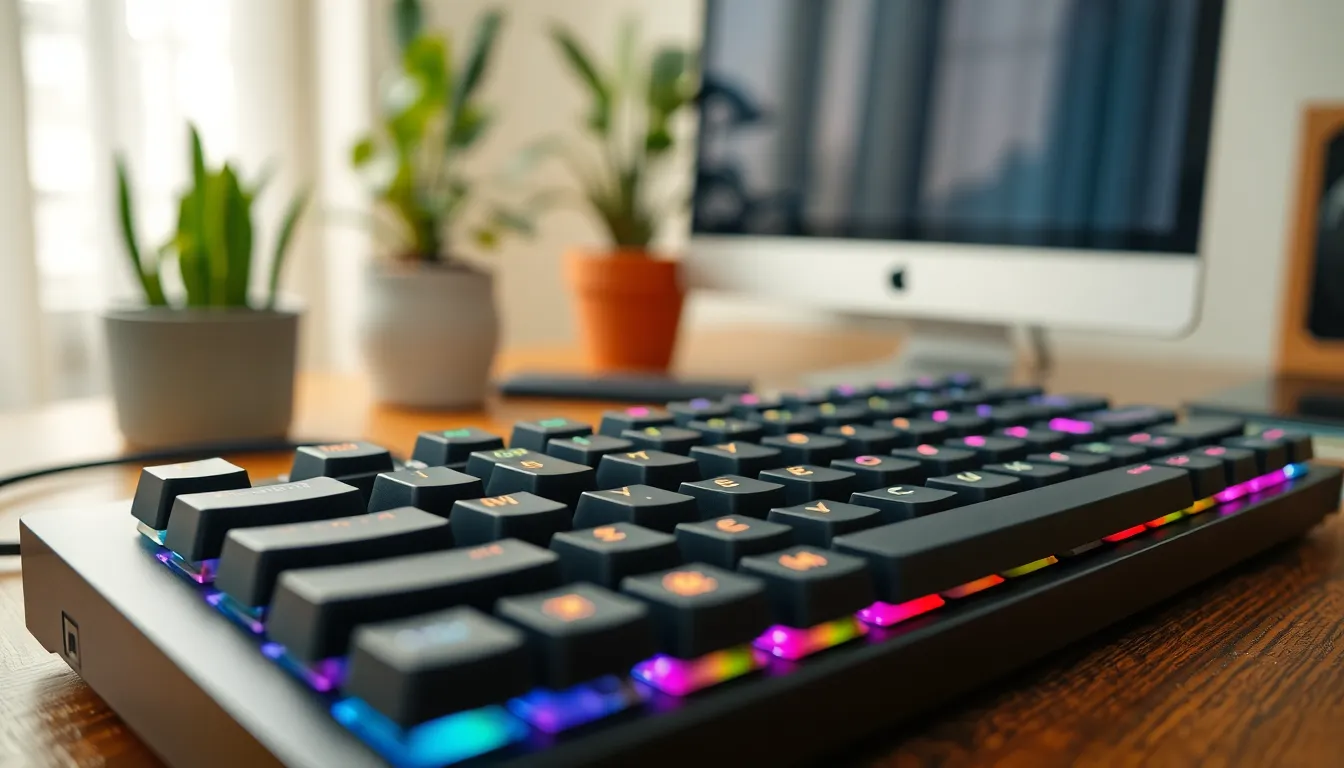When it comes to laptops, the keyboard is often the unsung hero. It’s the trusty sidekick that helps you conquer spreadsheets, craft emails, and unleash your creativity, all while enduring countless crumbs and coffee spills. But not all keyboards are created equal. From mechanical to chiclet, each type brings its own flair to the typing experience.
Table of Contents
ToggleOverview of Laptop Keyboard Types
Various laptop keyboard types cater to different user preferences and needs. Mechanical keyboards provide tactile feedback, making them popular among typists and gamers. Key switches in mechanical keyboards vary and offer distinct acoustic responses and actuation forces.
Chiclet keyboards feature flat keys with a wider spacing, enhancing portability without sacrificing comfort. Many modern laptops incorporate chiclet keyboards, providing a sleek design suitable for travel. The low-profile keys often include a scissor-switch mechanism, which improves key stability and reduces wobble.
Membrane keyboards consist of a soft, rubbery mat beneath the keycaps. These keyboards are typically quieter than mechanical options, making them ideal for quiet work environments. The design allows for quicker assembly, resulting in lower production costs.
Backlit keyboards enhance usability in low-light settings. Many users find illuminated keys particularly helpful for late-night work sessions. Different brightness levels allow customization based on individual preferences.
Ergonomic keyboards promote better posture and wrist alignment. This design minimizes strain during extended typing sessions, catering to those who type frequently. Built-in wrist rests often accompany ergonomic models for added comfort.
Lastly, some laptops incorporate hybrid keyboard designs. Such keyboards may combine features from mechanical and membrane options, providing versatility. Users benefit from the feedback of mechanical keys along with the softness of membranes.
Understanding the various keyboard types available assists users in selecting the best option. Each type offers unique characteristics, ensuring there’s a keyboard to fit different styles and environments.
Mechanical Laptop Keyboards

Mechanical keyboards offer a distinct typing experience that appeals to many users. These keyboards utilize individual mechanical switches for each key, providing tactile feedback and durability.
Benefits of Mechanical Keyboards
Mechanical keyboards enhance typing precision and speed. Users enjoy tactile feedback, allowing for confident, error-free typing. The durability of mechanical switches often exceeds 50 million keystrokes, ensuring longevity. Many mechanical keyboards also feature customizable keycaps and backlighting, allowing personalization for aesthetic appeal. Gamers prefer these keyboards for their fast response times and the ability to register multiple keys simultaneously. Users in typing-intensive professions often report less fatigue during extended sessions.
Drawbacks of Mechanical Keyboards
Mechanical keyboards can be heavier and bulkier, making them less portable than other types. The noise produced during typing may be disruptive in quiet environments. Users may also find certain mechanical switches too stiff, resulting in discomfort for some. Price can be another factor, as mechanical keyboards generally cost more than membrane keyboards. Additionally, limited battery life in wireless mechanical keyboards can be an inconvenience. Users should consider their specific needs before choosing this type of keyboard.
Membrane Laptop Keyboards
Membrane keyboards offer a quieter typing experience and often come at a lower cost. They function using a pressure pad system, allowing for a smooth keystroke.
Features of Membrane Keyboards
Typical features include a slim profile and a compact design, making them ideal for portable laptops. The keys are usually flat and silent, minimizing noise in shared environments. Additionally, membrane keyboards often incorporate spill resistance, providing protection against minor accidents. A lack of individual key switches contributes to a softer feel during typing, appealing to those who prefer less tactile feedback. Many models are lightweight, enhancing the overall portability of laptops.
Pros and Cons of Membrane Keyboards
Quiet operation serves as a significant advantage, making membrane keyboards suitable for offices and libraries. Lower production costs translate into more affordable laptop options for users. However, these keyboards may lack the tactile feedback found in mechanical counterparts, which could result in reduced typing accuracy. Durability remains a concern, as most membrane keyboards have a shorter lifespan compared to mechanical ones. Users might also miss customizable features, such as programmable keys and backlighting, commonly found in other keyboard types.
Chiclet Laptop Keyboards
Chiclet keyboards feature flat keys with wider spacing, making them a popular choice among users seeking portability and comfort. These designs incorporate an island-like layout for each key, enhancing overall typing accuracy. Users often appreciate the shallow depth of key travel, which promotes fast keystrokes. Additionally, chiclet keyboards maintain a sleek appearance, allowing for thinner laptop profiles that appeal to modern aesthetics.
Design and Functionality
Chiclet keyboards are characterized by their square, flat keys separated by small spaces. This layout aids in preventing accidental keystrokes during typing. These keyboards typically utilize a scissor-switch mechanism, providing a stable typing surface. Functionally, their compact design supports streamlined portability for users on the go. Manufacturers often integrate chiclet keyboards into ultrabooks and lightweight laptops, ensuring convenience without sacrificing usability.
Advantages and Disadvantages
Chiclet keyboards offer several advantages for users. They tend to be quieter than mechanical keyboards, making them suitable for shared workspaces. Their slim profile can enhance laptop portability, appealing to frequent travelers. However, they do have disadvantages. Some users find the reduced key travel can affect typing comfort during long sessions. The lack of tactile feedback may pose challenges for individuals who prefer a more responsive typing experience. Ultimately, users should weigh these pros and cons to determine if chiclet keyboards fit their typing style.
Scissor-Switch Laptop Keyboards
Scissor-switch keyboards provide a balance between a low-profile design and responsive typing experience. These keyboards feature a mechanism that utilizes a scissor-like structure to stabilize key movement.
Overview of Scissor-Switch Mechanism
The scissor-switch mechanism offers unique design benefits. Keycaps attach to the scissor arms, creating a stable and responsive feel. Stability enhances precision with each keystroke, allowing users to type comfortably and accurately. Many laptops use this mechanism to create slimmer profiles while minimizing key travel. As a result, the keys maintain a solid feel without being overly tall, making them ideal for portable devices.
Performance Characteristics
Performance characteristics of scissor-switch keyboards include responsiveness and durability. These keyboards typically offer a short actuation point, enabling faster typing speeds. Users often appreciate the quieter operation, which benefits shared environments. Key presses feel solid, promoting better typing accuracy over long periods. Many models provide tactile feedback that some users find satisfying, improving their overall experience. With durability often matching that of mechanical options, these keyboards withstand frequent use, adding to their appeal.
Choosing the right laptop keyboard can significantly enhance the overall user experience. Each type of keyboard offers distinct advantages tailored to different preferences and environments. Whether it’s the tactile feedback of mechanical keyboards or the sleek design of chiclet options, users have a variety of choices to suit their needs.
For those who prioritize quiet operation and portability, membrane keyboards may be the ideal choice. Meanwhile, scissor-switch keyboards strike a balance between responsiveness and low-profile design, appealing to many users. Understanding these options empowers individuals to make informed decisions that align with their typing styles and daily requirements. Ultimately, selecting the right keyboard type can lead to improved productivity and comfort during extended use.



